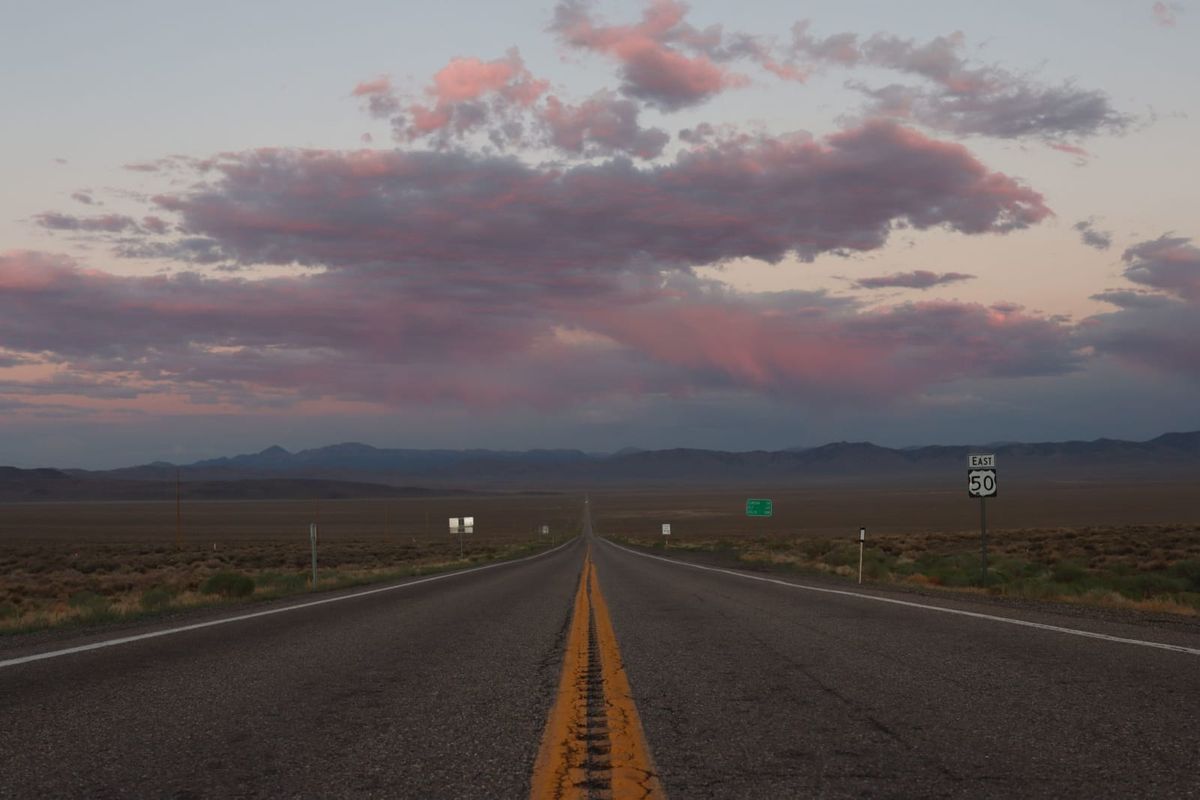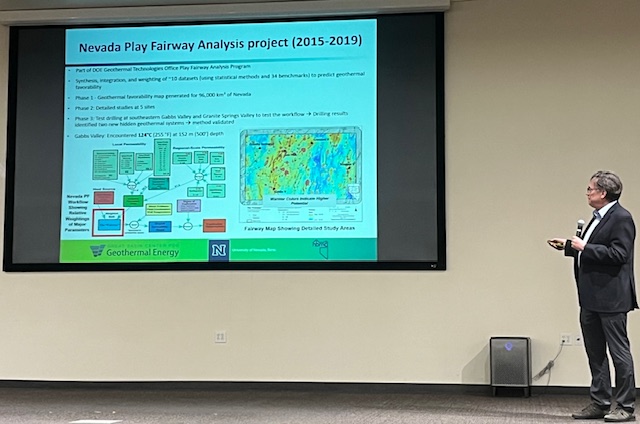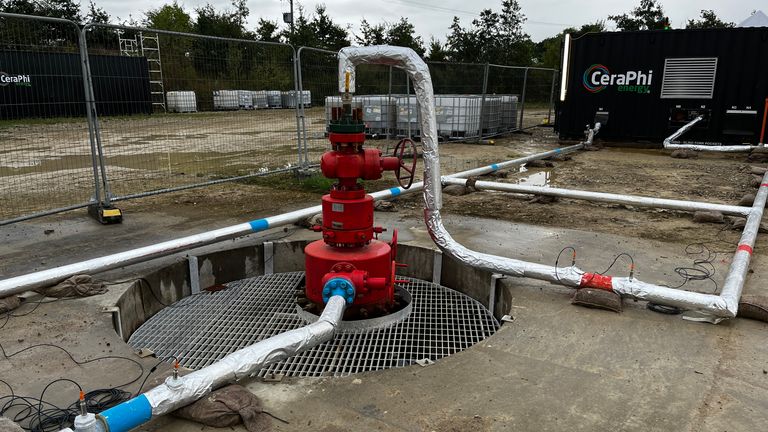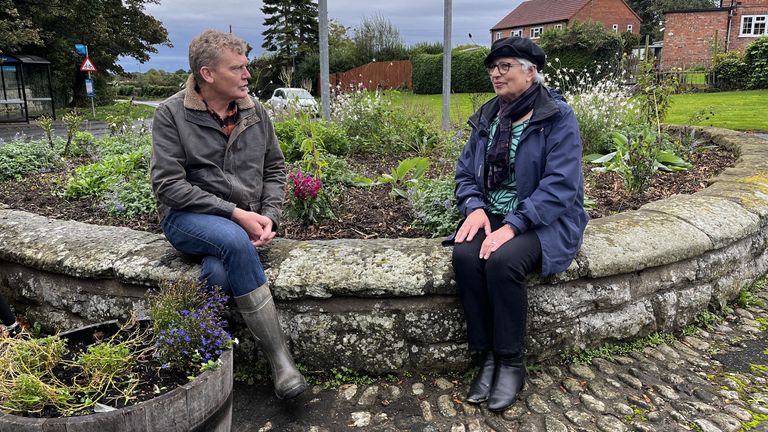GEOTHERMAL
There’s a Vast Source of Clean Energy Beneath Our Feet. And a Race to Tap It.
Brad Plumer
Tue, August 29, 2023
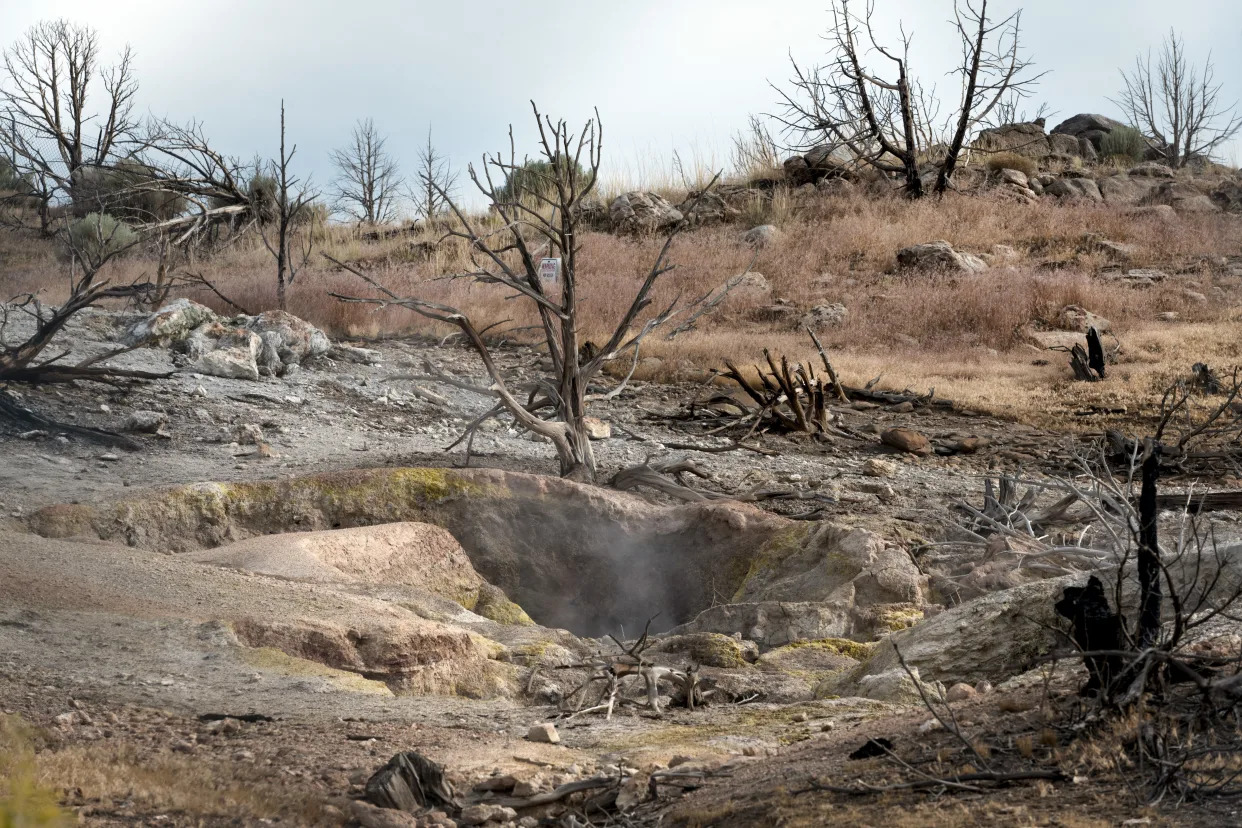
Steam rises from the Roosevelt Hot Springs, near the FORGE and Fervo geothermal sites outside of Milford, Utah, on July 31, 2023. (Brandon Thibodeaux/The New York Times)
BEAVER COUNTY, Utah — In a sagebrush valley full of wind turbines and solar panels in western Utah, Tim Latimer gazed up at a very different device he believes could be just as powerful for fighting climate change — maybe even more.
It was a drilling rig, of all things, transplanted from the oil fields of North Dakota. But the softly whirring rig wasn’t searching for fossil fuels. It was drilling for heat.
Latimer’s company, Fervo Energy, is part of an ambitious effort to unlock vast amounts of geothermal energy from Earth’s hot interior, a source of renewable power that could help displace fossil fuels that are dangerously warming the planet.
“There’s a virtually unlimited resource down there if we can get at it,” Latimer said. “Geothermal doesn’t use much land, it doesn’t produce emissions, it can complement wind and solar power. Everyone who looks into it gets obsessed with it.”
Traditional geothermal plants, which have existed for decades, work by tapping natural hot water reservoirs underground to power turbines that can generate electricity 24 hours a day. Few sites have the right conditions for this, however, so geothermal only produces 0.4% of America’s electricity.
But hot, dry rocks lie below the surface everywhere on the planet. And by using advanced drilling techniques developed by the oil and gas industry, some experts think it’s possible to tap that larger store of heat and create geothermal energy almost anywhere. The potential is enormous: The Energy Department estimates there’s enough energy in those rocks to power the entire country five times over and has launched a major push to develop technologies to harvest that heat.
Dozens of geothermal companies have emerged with ideas.
Fervo is using fracking techniques — similar to those used for oil and gas — to crack open dry, hot rock and inject water into the fractures, creating artificial geothermal reservoirs. Eavor, a Canadian startup, is building large underground radiators with drilling methods pioneered in Alberta’s oil sands. Others dream of using plasma or energy waves to drill even deeper and tap “superhot” temperatures that could cleanly power thousands of coal-fired power plants by substituting steam for coal.
Still, obstacles to geothermal expansion loom. Investors are wary of the cost and risks of novel geothermal projects. Some worry about water use or earthquakes from drilling. Permitting is difficult. And geothermal gets less federal support than other technologies.
Still, the growing interest in geothermal is driven by the fact that the United States has gotten extraordinarily good at drilling since the 2000s. Innovations like horizontal drilling and magnetic sensing have pushed oil and gas production to record highs, much to the dismay of environmentalists. But these innovations can be adapted for geothermal, where drilling can make up half the cost of projects.
“Everyone knows about cost declines for wind and solar,” said Cindy Taff, who worked at Shell for 36 years before joining Sage Geosystems, a geothermal startup in Houston. “But we also saw steep cost declines for oil and gas drilling during the shale revolution. If we can bring that to geothermal, the growth could be huge.”
States like California are increasingly desperate for clean energy sources that can run at all hours. While wind and solar power are growing fast, they rely on fossil fuels like natural gas for backup when the sun sets and wind fades. Finding a replacement for gas is an acute climate challenge, and geothermal is one of the few plausible options.
“Geothermal has historically been overlooked,” Sen. Lisa Murkowski, R-Alaska, said at a hearing. But with innovation, she added, “the potential is out there, I think, that’s pretty extraordinary.”
Fracking for Clean Energy
Near the town of Milford, Utah, sits the Blundell geothermal plant, surrounded by boiling mud pits, hissing steam vents and the skeletal ruins of a hot springs resort. Built in 1984, the 38-megawatt plant produces enough electricity for about 31,000 homes.
The Blundell plant relies on ancient volcanism and quirks of geology: Just below the surface are hot, naturally porous rocks that allow groundwater to percolate and heat up enough to create steam for generating electricity. But such conditions are rare. In much of the region, the underground hot rock is hard granite, and water can’t flow easily.
Three miles east, two teams are trying to tap that hot granite. One is Utah FORGE, a $220 million research effort funded by the Energy Department. The other is Fervo, a Houston-based startup.
Both use similar methods: First, drill two wells shaped like giant L’s, extending thousands of feet down into hot granite before curving and extending thousands of feet horizontally. Then, use fracking, which involves controlled explosives and high-pressure fluids, to create a series of cracks between the two wells. Finally, inject water into one well, where it will hopefully migrate through the cracks, heat up past 300 degrees Fahrenheit and come out the other well.
This is “enhanced geothermal,” and people have struggled with the engineering difficulties since the 1970s.
But in July, FORGE announced it had successfully sent water between two wells. Two weeks later, Fervo announced its own breakthrough: A 30-day test in Nevada found the process could produce enough heat for electricity. Fervo is now drilling wells for its first 400-megawatt commercial power plant in Utah, next to the FORGE site.
“Those are major accomplishments, in a time frame faster than we expected,” said Lauren Boyd, head of the Energy Department’s Geothermal Technologies Office, which estimates that geothermal could supply 12% of America’s electricity by 2050 if technology improves.
Latimer seemed less surprised. Before founding Fervo in 2017, he worked as a drilling engineer for BHP, an oil and gas firm. There, he became convinced that previous attempts at enhanced geothermal failed because they hadn’t taken advantage of oil and gas innovations like horizontal drilling or fiber-optic sensors.
Fervo didn’t invent many of the tools it uses. In Utah, drilling is conducted by Helmerich & Payne, a major oil and gas contractor that developed a high-tech rig with software and sensors that allow operators to precisely steer drill bits underground. Sixty percent of Fervo’s employees came from oil and gas.
“If we had to invent this stuff ourselves it would have taken years or decades,” Latimer said. “Our big insight was that people in geothermal simply weren’t talking enough to people in oil and gas.”
The hard part now is making enhanced geothermal affordable. The Energy Department wants costs to plummet to $45 per megawatt-hour for widespread deployment. Fervo’s costs are “much higher,” Latimer said, though he thinks repeated drilling can lower them.
Research at FORGE could help. Drilling deeper and hotter can make projects more cost-effective, since more heat means more energy. But existing oil and gas equipment wasn’t designed for temperatures above 350 degrees, so FORGE is testing new tools in hotter rock.
“No one else is willing to take the risks we can take,” said Joseph Moore, a University of Utah geologist who leads FORGE.
Enhanced geothermal faces other challenges, Moore cautioned. Underground geology is complex, and it’s tricky to create fractures that maintain heat and don’t lose too much water over time. Drillers must avoid triggering earthquakes, a problem that plagued geothermal projects in South Korea and Switzerland. FORGE closely monitors its Utah site for seismic activity and has found nothing worrisome.
Permitting is tough. While enhanced geothermal could, in theory, work anywhere, the best resources are on federal land, where regulatory reviews take years and it’s often easier to win permission for oil and gas drilling because of exemptions won by fossil fuel companies.
Still, interest is rising. California is struggling with electricity shortfalls and recently had to extend the life of three old, polluting gas plants. Regulators have ordered utilities to add 1,000 megawatts of electricity from clean sources that can run at all hours to backstop fluctuating wind and solar supplies. One electricity provider, Clean Power Alliance, agreed to buy 33 megawatts from Fervo’s Utah plant.
“If we can find it, we have a pretty big appetite for geothermal,” said Ted Bardacke, Clean Power Alliance’s CEO. “We’re adding more solar every year for daytime and have a huge build-out of batteries to shift power to the evening. But what do we do at night? That’s where geothermal can really help out.”
Underground Radiators and Superhot Rocks
Fervo faces fierce competition for the future of geothermal.
One alternative is a “closed loop” system, which involves drilling sealed pipes into hot, dry rocks and then circulating fluid through the pipes, creating a giant radiator. This avoids the unpredictability of water flowing through underground rock and doesn’t involve fracking, which is banned in some areas. The downside: more complicated drilling.
Eavor, a Calgary-based company, has already tested a closed-loop system in Alberta and is now building its first 65-megawatt plant in Germany.
“If geothermal is ever going to scale, it has to be a repeatable process you can do over and over,” said John Redfern, Eavor’s CEO. “We think we’ve got the best way to do that.”
In Texas, Sage Geosystems is pursuing fracked wells that act as batteries. When there’s surplus electricity on the grid, water gets pumped into the well. In times of need, pressure and heat in the fractures pushes water back up, delivering energy.
The most audacious vision for geothermal is to drill 6 miles or more underground where temperatures exceed 750 degrees Fahrenheit. At that point, water goes supercritical and can hold five to 10 times as much energy as normal steam. If it works, experts say, “superhot” geothermal could provide cheap, abundant clean energy anywhere.
“The ultimate goal should be to get to the superhot stuff,” said Bruce Hill of the Clean Air Task Force, an environmental group.
But going that deep requires futuristic tools. GA Drilling, a Slovakian company, is developing plasma torches for drilling at high temperatures. Quaise, a Massachusetts-based startup, wants to use millimeter waves — high-frequency microwaves — to pulverize rock and reach depths of up to 12 miles.
“There are huge engineering challenges,” said Carlos Araque, Quaise’s CEO.
“But,” he added, “imagine if you could drill down next to a coal plant and get steam that’s hot enough to power that plant’s turbines. Replacing coal at thousands of coal plants around the world. That’s the level of geothermal we’re trying to unlock.”
Oil Interest
The U.S. government plays a leading role in nurturing risky new energy technologies. But lawmakers often overlook geothermal. The recent infrastructure bill provided $9.5 billion for clean hydrogen but just $84 million for advanced geothermal.
“It’s been hard for geothermal to fight its way into the conversation,” said Jamie Beard, founder of Project InnerSpace, a Texas-based nonprofit that promotes geothermal.
Beard has spent years trying to get oil and gas companies excited about geothermal. That’s slowly happening: Devon Energy invested $10 million into Fervo, while BP and Chevron are backing Eavor. Nabors, a drilling-service provider, has invested in GA Drilling, Quaise and Sage.
In Oklahoma, a consortium of oil and gas firms led by Baker Hughes recently launched an effort to explore converting abandoned wells into geothermal plants.
“Historically, the upfront costs and risks of geothermal have been challenging,” said Ajit Menon, vice president for geothermal at Baker Hughes. “But we think it’s got a huge role to play. And we have workers with the right skills, the right technology. You can see why it makes sense for us.”
c.2023 The New York Times Company

